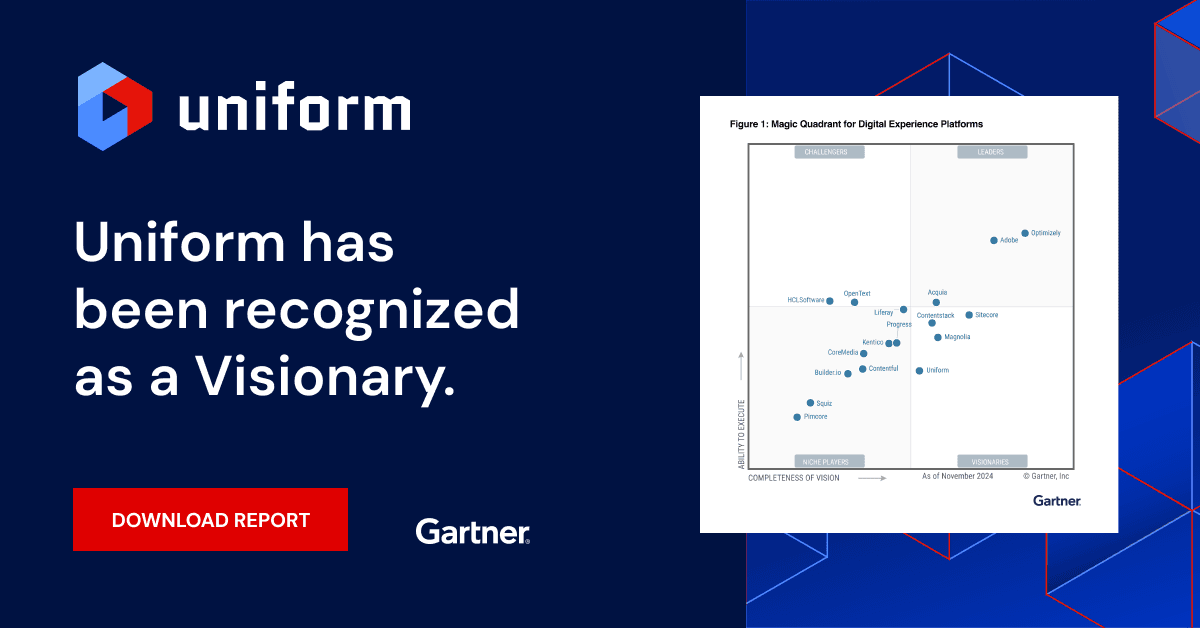Uniform blog/Content entry patterns: connecting any source with your digital channels
Content entry patterns: connecting any source with your digital channels
Content entry patterns: connecting any source with your digital channels
Enterprise content or data tends to be fragmented across various sources making it difficult to access and consolidate for reuse in digital experiences.
The demand for content aggregation from multiple sources has grown in recent years due to the shift towards headless and composable architectures. The increased complexity of modern marketing and eCommerce tech stacks also contributes to this demand in order to provide omnichannel experiences to customers. The process of aggregating content from various sources is known as "Content Federation".
Main challenges when federating content from external sources
When unifying and connecting content from multiple sources, a few key challenges must be addressed:
- Connecting content: How is content from external systems discovered and referenced?
- Resolving & delivering unified content: How is external content resolved and delivered for consumption in digital channels efficiently and scalable?
- Unifying external content: How can marketers or non-technical users utilize and enrich external content in a granular and flexible manner to create experiences?
Content federation is generally handled from a system integration perspective, typically within the developers' realm. The main focus is to create references between content and resolve it at delivery time. This is often achieved by giving content editors a visual entity selector, such as a product picker, and then storing the ID of the selected object. While some vendors also handle resolving these external content or data references on the delivery side, it's often the developers' responsibility to build their own performant and scalable solutions. These are usually implemented as a Backend for Frontend (BFF) API, which can be complex and expensive to build and maintain.
Focusing solely on the technical aspects of connecting external content and resolving it for delivery neglects the most crucial challenge of content federation: how can your content editors effectively work with external content?
Put your external content to work
When external content is merely referenced and resolved as a whole item, it doesn't provide editors insight into how it would look or what it contains. This limited control over the display or use of external content, as developers predefine it, can inhibit content creators and reduce how content can be reused effectively.
Ideally, editors should be able to perform tasks with external content to create rich customer experiences:
- Compose content from multiple sources: Connect to various external sources to collect all necessary content and metadata for a specific content type.
- Enrich external content: Add extra photos, tags, or categories. Create description text of varying lengths or tones of voice to suit different audiences or channels. Connect to related content items and add metadata to support search or SEO use cases.
- Curate content: Create lists of selected content items or selectively modify particular fields of the remote content, such as replacing the featured image.
- Unify content from multiple sources: Consolidate content into one cohesive content repository. The goal is to create a unified content type, providing a consistent and comprehensive view of the content, irrespective of its origin.
We believe that the content source should not impact content editors. They should be able to flexibly carry out their tasks with any type of content, whether locally created, externally sourced, or a mixture of both.
Introducing Entry Patterns
Entry patterns are a powerful addition to Uniform's built-in CMS to empower content creators to work with external content in a genuinely composable way. By applying the proven concept of patterns to content types you can create entries from any external content source.
An entry pattern is essentially a content type template configured to connect to specific types of external content. It defines which data or content to fetch from these sources and maps the attributes of this external data to the content type's fields. With our Mesh framework and over 40 pre-built integrations, you can provide your content editors with a flexible and visually intuitive selection experience.
You can define multiple entry patterns for each content type if you need to connect to different sources for the same content, like multiple CMS or PIM systems.
Entry patterns are Uniform's answer to content federation for structured content, addressing its challenges in unique ways that empower marketers and content editors, and that goes beyond connecting and resolving external content via APIs.
Let’s examine how this is achieved.
Connecting content
Based on an entry pattern, you can create entries where the content editor need only select the external content objects to represent. With just a few clicks, any field of the entry with mapping to the external content is populated, and the editor can see which data is available for editing.
This entry can then be used like any other entry in the Uniform CMS. The fact that content is sourced from an external system becomes secondary as your content is unified.
One additional great power of entry patterns is that you can define override settings to shape the authoring experience by allowing certain fields or data resources to be overridden for an entry that is based on an entry pattern.
Resolving & delivering unified content
Like compositions, entries in Uniform support resolving and caching external data on the CDN edge, a process we call Edgehancing. This guarantees that even complex entries composed from multiple sources have cached response times below 100 ms on a global scale.
The original content or data remains at the source location and is resolved in real time when an uncached request is made. The response is cached and also made available in our recently introduced powerful search and filtering capabilities for content entries. This means you can also search, filter and sort on attributes that are resolved from external sources like filtering by a price range of a product just like you would with any kind of local content.
Unifying external content
The primary benefit of entry patterns is their ability to unify content, which can then be utilized in numerous practical ways. We will now examine examples of the various use cases mentioned earlier, demonstrating how entry patterns assist content editors in unifying external content and repurposing it across a wide range of applications.
Use case 1: Compose content from multiple sources
Example: eCommerce application
For representing a “Product” content type, a comprehensive view of all product attributes might involve complex aggregation from the following sources:
- Basic product data from a Product Information Management system (PIM)
- Product photos and videos from a Digital Asset Management system (DAM)
- Pricing and inventory details from an Enterprise Resource Planning system (ERP)
- Additional content from a Content Management System (CMS)
By combining all of these commerce data sources into unified entries, you have a holistic view of your products and can utilize all its fields and metadata in creative ways.
Example: Travel website
For a “Destination” content type, create an entry pattern that combines manually managed content with live travel data such as local weather, hotel or flight offers, local news or social feeds.
Use case 2: Enrich external content
Example: Cinema website
For a “Movie” content type, use an entry pattern to pull information from specialized APIs like IMDB for movie data or Rotten Tomatoes for ratings. Then, enrich the movie entry with content, like show times, or media, like movie trailers.
Example: Multi-source content search
Enrich entries based on entry patterns with additional metadata (such as tags or categories), or additional content to make them easier to discover in a unified search application.
Use case 3: Curate content
Example: Product recommendations in online retail
Create collections or bundles of recommended or featured products sourced from external systems. Optionally, adapt specific fields on a product, such as the featured image, to display an optimized version.
Use case 4: Unify content from multiple sources
Example: Article knowledge base
You can create a unified "Article" content type using entry patterns if your articles are stored in different CMS instances or a legacy CMS. This will allow you to have a single content repository, which can power a knowledge base.
Entry Patterns: The Swiss Army Knife for federating structured content
These examples demonstrate the many creative ways content editors can use entry patterns. There are more use cases, such as phasing out legacy systems or using them as content presets, still yet to cover. These use cases for entry patterns are not exclusive, and they can be combined to suit your content management needs. You can connect, compose, curate, unify, and enrich content from any source for any digital channel in any manner you see fit.
Please consult our documentation on patterns and entry patterns. This will help you understand how to utilize our content federation solution that empowers marketers and content creators.





.png&w=1080&q=90)

